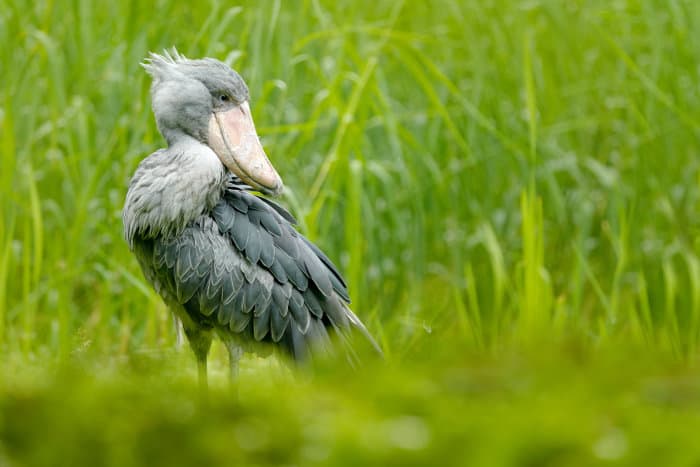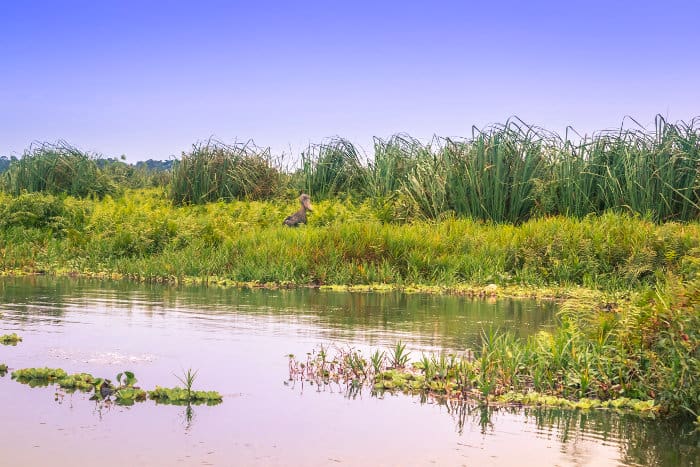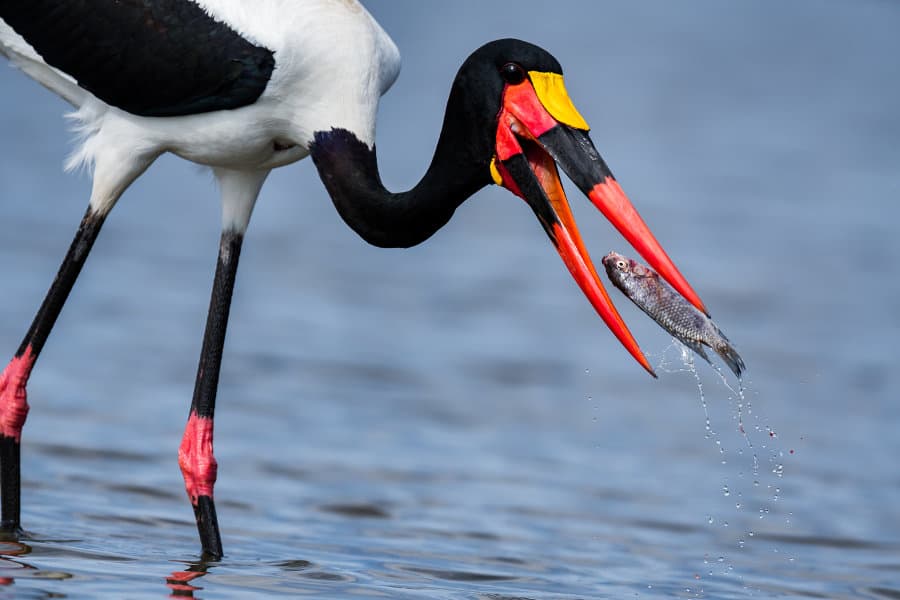Ever heard a machine gun go off?
Well, listening to a shoebill stork’s mating call sure gives you the chance to hear one. This gigantic bird looks as though it came from some prehistoric dinosaur time.
The shoebill stork, also known as the whale-headed stork, or shoe-billed stork, is a big grey bird scientifically named as Balaeniceps Rex.
Shoebill storks are found in marshes, wetlands, and swampy areas in eastern Africa. Spotting one of these giant dinosaur-like birds on a safari tour is undoubtedly a must-see.
What Does a Shoebill Stork Sound Like?

Shoebills don’t make much noise and are usually silent birds. They are masters of patience and can stand in the water like statues for endless hours – waiting for their next prey to swim by.
The time when they do make noise is mating time. It sounds similar to hippopotamus’ call but on steroids.
The birds release a loud interjection making a bill-clattering display to attract a partner. This sound is loud and frankly quite freaky.
However, to a mate, it’s the main attraction during nesting season.
The shoebill produces its sound by clapping the lower jaw and upper jaw of its bill together, producing a loud hollow sound.
These are quick repetitive bursts sounding like a machine gun, or tribal drums beating.
When shoebill chicks solicit food, their sound is similar to a human with hiccups. Adults produce loud repetitive sounds as a form of communication.
8 Interesting Facts About Shoebill Storks
In disregard of their heavy weight and portion, these birds are shy creatures. There is a lot more to this awkward bird than the eye can see – or hear.
Here are 8 interesting facts to answer your questions.
1. Shoebill beaks are shaped like a shoe

The “shoebill stork” got its name for its prominent beak that is shaped like a shoe.
The beak is oddly long and broad, with a sharp nail at the end of its mandible. The sharp nail is used to catch and eat slippery fish and small animals.
Their favorite food is the lungfish, but they can also eat baby turtles, amphibians, lizards, snakes, and even small crocodiles.
Their beaks can grow up to a quarter in size of their bodies – up to 22 centimeters in length and 10 centimeters in width. Their large bills may appear as a cruel joke from nature, but it can be a lethal tool.
2. A shoebill height can reach 1,4 meters
How big is a shoebill stork?
The shoebill bird can reach a height of 1.4 meters. That is the same height as actor Gary Coleman – that is one large bird!
Their bodies are covered in grey feathers, with long thin legs and big feet.
3. Shoebill storks aren’t storks at all

The African shoebill is considered closely related to herons and pelicans.
They were first categorized under Ciconiiformes along with the black stork and marabou stork. After genetic testing, they were recategorized as Pelecaniformes.
They are now categorized as a single species to the Balaenicipitidae family. However, unlike pelicans and herons, they don’t nest in colonies. Instead, their nests are dispersed far apart.
4. Shoebill storks live in solitary
Shoebill storks live in solitary and are very territorial.
They eat alone, live alone, and even when they are paired together, they will still hunt and eat away from one another. It is rare to see two shoebill storks next to each other.
Mating season only happens during the dry season to prevent flooding of nests. The birds separate once the mating season is over.
5. Their offspring leave the nest at 2.5 months old

A shoebill stork sits on a nest of eggs that take about 30 days to hatch. They feed their young up to three times a day by regurgitating food.
Once the offspring reach about 10 weeks old, they are entirely on their own. The baby shoebill is removed from the nest once it can hunt and fend for itself.
Although they are solitary birds, during the nesting phase both parents participate in the development of their young, from the nest building, feeding, and rearing process.
6. The shoebill stork is an endangered species
According to the IUCN, there are only 3,300-5,300 mature adults left in the wild, meaning they are nearing extinction. The birds are vulnerable due to hunting, cultural taboos, and the destruction of their environments.
Many cultures believe shoebills bring bad luck. Some are required to hunt the birds to cleanse their land.
Many zoos keep the stork-like birds captive to help them survive. However, due to stress and unfamiliar environments, the shoebills refuse to mate, depleting the population. For zoos, these animals are considered the most expensive to buy.
Shoebill storks are non-migratory birds and have specific needs for foraging and nesting in their habitats. Many of their habitats are being destroyed and converted into agricultural land, leaving them helpless.
7. The shoebill storks nesting patterns

These large birds build their nests in swamp grass, floating vegetation, or solid heaps. A popular, durable plant they like to use is papyrus. Shoebills usually lay one to three large eggs.
The shoebill stork lives in wet marshes found in Sudan, Zambia, Uganda, and Rwanda. These marshes or swamps are wetlands covered in water and tall grasses.
8. These large birds can fly
The shoebill may be a sizable feathered bird, but it can undoubtedly fly too.
The shoebill stork’s wingspan can get as long as 2.5 meters – making it five times larger than their bodies.
Like other birds of prey, they use their wings to intimidate, fly, and balance.
Though they are large and powerful, these fantastic creatures can only flap their wings at 150 wing flaps per minute — the slowest flap rate of its species.
The Dino-Bird Has a Simply Unique Sound

These imposing birds can be intimidating to look at. Their deep staring eyes, oversized bills, or better yet that shrieking sound they make.
The machine gun clicking sound is only attractive to a mate, but fascinates nevertheless. The world needs to know and appreciate these magnificent creatures that live in Africa’s watery shallows.



